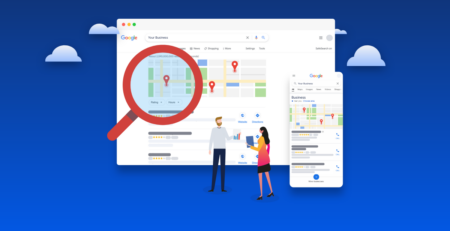In today’s fast-paced digital landscape, providing efficient and effective customer support is a must for any business to thrive. A knowledge base serves as a centralized repository of information. It offers customers self-service resources that equip them with the ability to find answers to their questions quickly and conveniently. Companies can enhance the customer experience, reduce support costs, and gain a competitive edge by implementing a knowledge base.
Building a knowledge repository where you can accumulate the wealth of knowledge your company holds can be a daunting task. Choosing the complexity and scope of the content depends entirely on the audience you have. If your consumers have technical know-how, you will address more complex challenges, but if they are not usually as well-versed, your knowledge base will cover the basics.
Regardless of the specific content you choose, this guide can make the process of developing a knowledge base simple and straightforward.
Table of Contents
Understanding your Audience
Customer service starts with understanding your customer. Thorough audience research forms the foundation of this understanding, allowing businesses to gain insights into the demographics, preferences, and behaviors of their customers. By conducting comprehensive market analysis, businesses can identify key demographic segments and understand their unique characteristics, such as age, gender, location, income level, and occupation. This research helps businesses tailor their services and address the concerns of their target audience.
Customer personas can further enhance this understanding by creating fictional representations of ideal customers based on the insights gathered from audience research. These personas typically include detailed information about the target audience’s demographics, interests, pain points, goals, and purchasing behaviors. By developing personas, businesses can humanize their target audience and gain a deeper understanding of their motivations and preferences. They can craft a more targeted knowledge base with an understanding of the age, education level, and skills of their average customer.
Businesses must also analyze common customer queries and pain points to effectively address them. Monitor customer interactions across various channels, such as customer support tickets, social media comments, and website inquiries to identify recurring themes and issues that customers encounter. This insight enables businesses to proactively address common concerns by creating informative content, updating product features, or implementing new support channels. Anticipating and resolving customer queries and pain points will help you enhance the overall customer experience.
Choosing the Right Platform
Choosing the right platform for your knowledge repository is essential for providing seamless and effective customer support. When you evaluate different options, consider factors such as cost, ease of use, and customization capabilities. Look for a platform that aligns with your budget and offers flexible pricing plans to accommodate your business’s needs as it grows. Ease of use ensures that both customers and support agents can navigate the knowledge base effortlessly. Prioritize customization capabilities to tailor the platform to your brand’s unique requirements and aesthetics. Integration with existing systems and workflows is also important for streamlining operations and maximizing efficiency.
Several platforms offer robust solutions for creating a knowledge base. One popular option is Zendesk Guide, known for its user-friendly interface and seamless integration with Zendesk’s suite of customer support tools. Another choice is Freshdesk, which offers customizable templates and advanced analytics capabilities to track knowledge base performance. Helpjuice also stands out, especially for its extensive customization options and intuitive content management system. Ultimately, the choice of platform depends on factors such as budget, scalability, and specific feature requirements.
Organizing Your Content
Organize your content effectively to create a user-friendly and navigable knowledge repository. Define a clear taxonomy. Group related topics into categories and subcategories. This hierarchical structure will allow users to locate relevant information quickly and intuitively. You should also take the customer journey into account to enhance usability for new customers to ensure that they do not leave your site due to confusion.
Utilize descriptive titles and concise summaries for each article to provide users with a clear understanding of its contents at a glance. Incorporate tags and keywords to facilitate searchability and ensure that users can easily find relevant articles using the search function.
Regularly review and update your content to reflect changes in products, services, or customer needs. This ensures that the knowledge base remains relevant and up-to-date over time. Invest time and effort into organizing your content thoughtfully and creating a knowledge base that empowers users to find answers independently.
Creating High-Quality Content
High-quality content for your knowledge base is crucial for providing valuable assistance to your customers. Start by thoroughly understanding your audience’s needs and preferences through customer research. Use this insight to craft comprehensive articles that address common queries and pain points. Keep your content clear, concise, and easy to understand, avoiding jargon or technical language that may confuse readers.
Utilize multimedia elements such as images, screenshots, and videos to enhance comprehension and engagement. Visual aids can help illustrate complex concepts and guide users through step-by-step processes more effectively.
Regularly review and update your content to ensure its accuracy and relevance. Products, services, and industry standards may change over time, so it is important to keep your knowledge base up-to-date with the latest information.
Lastly, encourage user feedback and engagement to identify areas for improvement and address any gaps in your content. Continuously refine and enhance your content to develop a valuable resource that empowers customers and enhances their overall experience with your brand.

Promote your Knowledge Base
Promote your knowledge base to ensure that customers are aware of its existence and can easily access the valuable resources it offers. Integrate links to the knowledge base prominently on your website, to make it easily accessible from your homepage and other relevant pages. Consider using pop-up notifications or banners to encourage users to explore the knowledge base when they visit your site.
Utilize email marketing to promote the knowledge base to your existing customer base. Send out newsletters that highlight new articles, helpful tips, or frequently asked questions that are available in the knowledge base. You can also include links to relevant knowledge base articles in your email signature or automated email responses.
Harness the power of social media to promote your knowledge base to a wider audience. Share informative articles, tutorials, or troubleshooting guides on your social media channels, and encourage followers to visit your knowledge base for more information. Include user generated content to show customers using your base to navigate problems. You can also engage with customers directly on social media by responding to inquiries with links to relevant knowledge base articles.
Offer incentives or rewards for customers who engage with the knowledge base, such as discounts or exclusive access to premium content. By promoting your knowledge base through multiple channels and incentivizing user engagement, you can maximize its reach and impact.
Provide Ongoing Support
Providing ongoing support ensures that your knowledge base remains a valuable resource for customers long after its initial implementation. Offer multiple channels for support, including live chat, email, and phone support, for customers with complex or urgent issues that cannot be resolved through self-service. Train your customer support agents to effectively leverage their knowledge base when assisting customers.
Solicit feedback from users to identify areas for improvement and address common pain points. Regularly update and expand your knowledge base content to reflect changes in products, services, or customer needs. Comprehensive and up-to-date support allows you to enhance the overall customer experience and build stronger relationships with your audience.
Set Up a Chatbot
Chatbots are extremely helpful customer service tools that can significantly enhance the customer support experience. They provide real-time assistance and streamline interactions. Select a chatbot platform that aligns with your business needs and integrates seamlessly with your knowledge base software. Configure the chatbot to handle frequently asked questions and guide users to relevant articles or resources within the knowledge base. Implement natural language processing capabilities to enable the chatbot to understand and respond to user queries more effectively.
By deploying a chatbot, you can provide round-the-clock support to customers, even outside of traditional business hours. It will improve your company’s accessibility and responsiveness. Chatbots can handle a high volume of inquiries simultaneously, reducing wait times for customers and increasing efficiency for your support team.
These bots also collect valuable data and insights about customer preferences, behaviors, and pain points, which can inform future content creation and service improvements. Regularly analyze chatbot interactions and user feedback to identify areas for optimization and refinement. Integrating a chatbot into your knowledge base can further facilitate your customers’ self-service capabilities and improve customer satisfaction.
Measuring Success
Measuring the success of your knowledge base allows you to evaluate its effectiveness and identify areas for improvement. Utilize analytics tools to track key performance indicators such as search usage, article views, and resolution times. Analyze these metrics to gain insights into how customers are interacting with the knowledge base and where they may be encountering difficulties.
Pay attention to search queries to understand what topics customers are searching for most frequently and whether they are finding relevant results. Monitor article views to identify popular content and areas of interest among users. Additionally, track resolution times to assess how quickly customers are able to find solutions to their inquiries.
Regularly review analytics reports to identify trends and patterns over time. Use this data to inform content creation strategies, prioritize updates and improvements, and optimize the overall user experience of the knowledge base. By leveraging analytics effectively, you can ensure that your knowledge base continues to meet the evolving needs of your customers.
Why You Should Develop a Knowledge Base
Developing a knowledge base is a complex process, but it has vast benefits that make this process worth the effort.
Enhanced Customer Experience
Knowledge bases provide customers with easy access to self-service resources. A knowledge base empowers them to find answers to their questions quickly and conveniently, without the need to contact customer support. This reduces frustration and wait times, leading to higher levels of satisfaction and loyalty.
These bases also enhance the customer experience by offering support around the clock, even outside of traditional business hours. This flexibility improves accessibility and responsiveness, further enhancing the overall customer experience.
You can standardize your support processes and ensure consistency in the information provided to customers with a knowledge base. An enhanced customer experience through a knowledge base leads to greater customer satisfaction, retention, and advocacy.
Cost Savings
Implementing a knowledge base can lead to significant cost savings for businesses. By providing customers with self-service resources, a knowledge base reduces the volume of inquiries handled by live support agents, decreasing the need for staffing resources. This increase in efficiency can translate into substantial cost reductions in customer support operations.
A knowledge base enables businesses to scale their support efforts more effectively without proportionately increasing costs. As customer inquiries grow, the knowledge base can handle a larger portion of them. They can reduce the need for additional support staff or resources.
Deflecting repetitive inquiries and standardizing support processes will save both time and resources spent on resolving common issues. This allows businesses to reallocate resources to other areas of operations or invest in further improving the customer experience.
Improved Agent Productivity
Implementing a knowledge base can equip support teams with a centralized repository of information and resources. Agents can quickly access relevant articles, tutorials, and troubleshooting guides to assist customers more effectively and efficiently. This reduces the time spent searching for information or consulting colleagues, enabling agents to resolve inquiries faster and handle a higher volume of cases.
A knowledge base streamlines the process of sharing knowledge and best practices among team members, fostering collaboration and reducing duplicate efforts. Agents can contribute their expertise to the knowledge base, enriching its content and ensuring that it remains comprehensive and up-to-date. A knowledge base enables them to deliver faster, more accurate support, ultimately increasing productivity and improving the overall customer experience.
Scalability
Scalability is a key advantage of implementing a knowledge base. It allows businesses to adapt and grow their support infrastructure in response to changing needs and increasing customer volumes. A well-designed knowledge base can accommodate a growing user base and expanding product or service offerings without sacrificing performance or user experience.
As customer inquiries increase, the knowledge base can efficiently handle a higher volume of requests. It reduces the strain on live support channels and minimizes wait times for customers. Businesses can easily scale their knowledge base by adding new content, updating existing resources, and expanding the platform’s functionality to meet evolving requirements. This makes knowledge bases an effective form of support for their growth trajectory. It ensures that their support infrastructure remains robust and responsive to customer needs.
Knowledge Sharing and Collaboration
Knowledge bases allow you to easily share and disperse knowledge within an organization. By centralizing information and best practices in a single repository, they facilitate the exchange of expertise among team members. Employees can easily access and contribute to the knowledge base, sharing insights, solutions, and lessons learned from their experiences.
This collaborative approach to knowledge sharing fosters a culture of learning and continuous improvement within the organization. Team members can leverage each other’s expertise to solve problems more effectively, accelerate decision-making processes, and avoid reinventing the wheel.
Capturing institutional knowledge in a knowledge base allows organizations to mitigate the risk of knowledge loss due to employee turnover or transitions. The knowledge base serves as a valuable resource for onboarding new employees, ensuring that they have access to the information they need to succeed from day one.
Competitive Advantage
Implementing a knowledge base can provide a significant competitive advantage for businesses by enhancing their customer support capabilities and distinguishing them from competitors. By offering a comprehensive and user-friendly self-service support experience, businesses can differentiate themselves in the market and strengthen their brand reputation.
A knowledge base demonstrates a commitment to customer service excellence and positions businesses as trusted authorities in their respective industries. Customers are more likely to choose a brand that provides easy access to helpful resources and demonstrates a proactive approach to addressing their needs.
Moreover, a knowledge repository can drive customer loyalty and retention by empowering users to find solutions independently and efficiently. As customers become more self-sufficient and experience fewer barriers to obtaining assistance, they are more likely to remain loyal to the brand and recommend it to others.
Additionally, a knowledge base can help businesses stay ahead of the competition by enabling faster response times, reducing support costs, and fostering innovation. By continuously refining and expanding their knowledge base content and functionality, businesses can maintain a competitive edge and adapt to evolving customer needs and market trends.
Implementing a knowledge repository is essential for businesses looking to enhance their customer support efforts and stay competitive in today’s market. Providing customers with easy access to valuable resources empowers them to find solutions independently. It allows companies to improve satisfaction levels and drive loyalty by improving your customer service. Ultimately, it allows you to engage your customers more effectively and develop a positive relationship with them.
















